zigbee
Latest
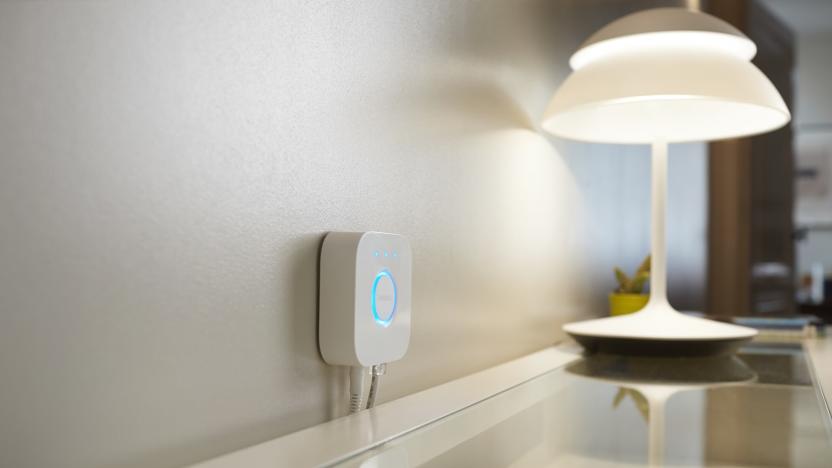
Philips patched a longstanding Hue bulb security flaw
Philips and its parent company Signify have patched another Hue smart light bulb vulnerability. Fortunately, the flaw was discovered by security researchers at CheckPoint Software, and it's unlikely that it was exploited in the wild. But this isn't the first time researchers have shown how smart home products, and Hue lights specifically, could give hackers access to entire home or business networks.

Abode will add HomeKit to its new smart home hub
Brilliant isn't the only smart home hub creator hopping on the HomeKit bandwagon. Abode has revealed its Gen 2 gateway, and it's "100% committed" to bringing HomeKit support to the platform. More details will come "soon," the company said. However, this already makes it one of the more flexible hubs to date. It can already communicate with Amazon Alexa, Google Assistant and IFTTT, and it supports a raft of smart home devices using Z-Wave Plus, Zigbee and Abode's own abodeRF.
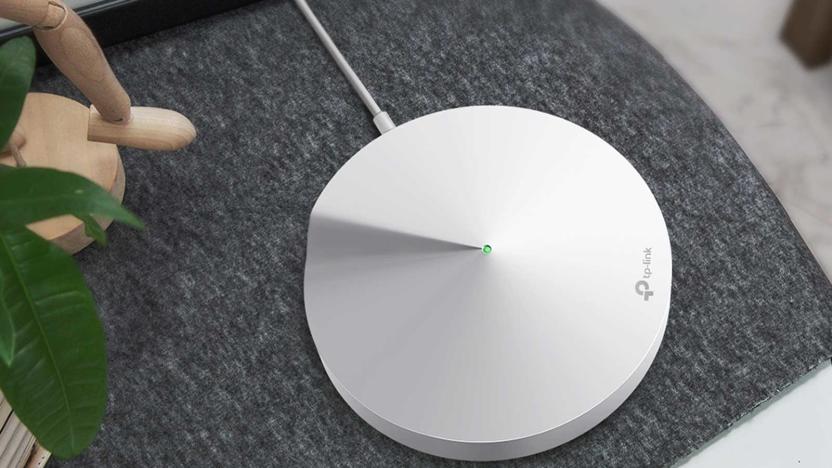
TP-Link squeezed a smart home hub into its new mesh WiFi router
Mesh WiFi routers are no longer all that special, so how do you stand out? If you're TP-Link, you roll in a smart home hub. It just introduced a Deco M9 Plus router that builds on last year's model with a hub for ZigBee- and Bluetooth-based devices like light bulbs and thermostats. If you're not fond of connecting dedicated hubs and bridges but still want good whole-home networking coverage, this might scratch your itch. TP-Link is promising compatibility with Alexa and IFTTT commands when steering your household gadgets.
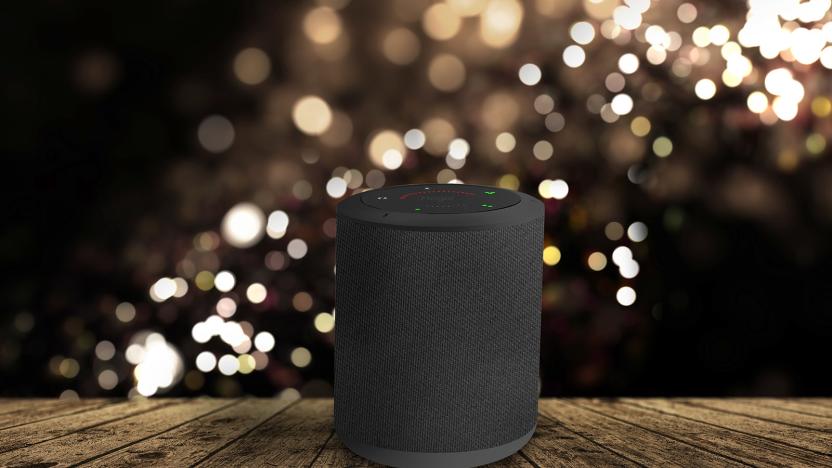
Hogar's Google Assistant speaker has a built-in smart home hub
Hogar Controls has unveiled the Google Assistant-powered Milo Smart Home Speaker with a built-in home hub that supports the Z-Wave Plus and Zigbee home automation standards. The versatile device can get you the news and weather from Google's AI, stream music across Bluetooth and WiFi, and control your blinds, lights, locks, thermostats and other devices via the hub.
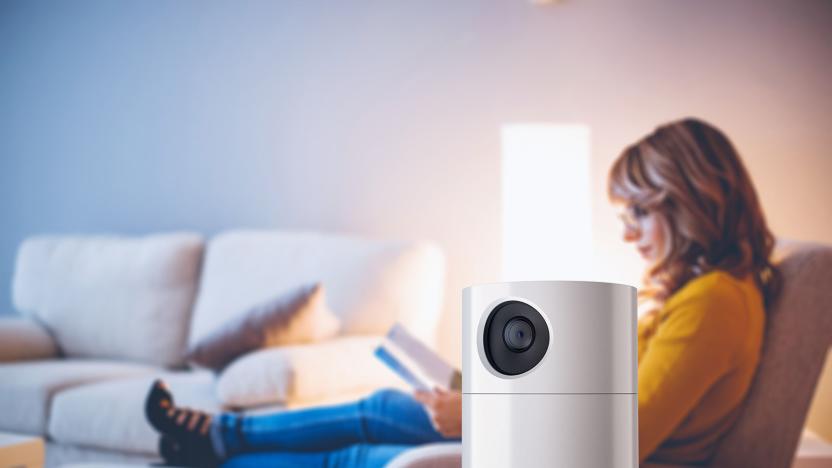
Toshiba's Symbio is both a security camera and Alexa speaker
Toshiba has integrated a dizzying number of devices into one with its new Symbio. It's an Alexa-powered smart speaker, security camera, intercom, smart home hub that's compatible with Z-Wave or Zigbee, and sound detector. Using the iOS or Android-powered Toshiba Smart Home app, you can "control everything from lights and music to door locks and temperature settings, from any location -- at home, at the office or out of town," the company claims.
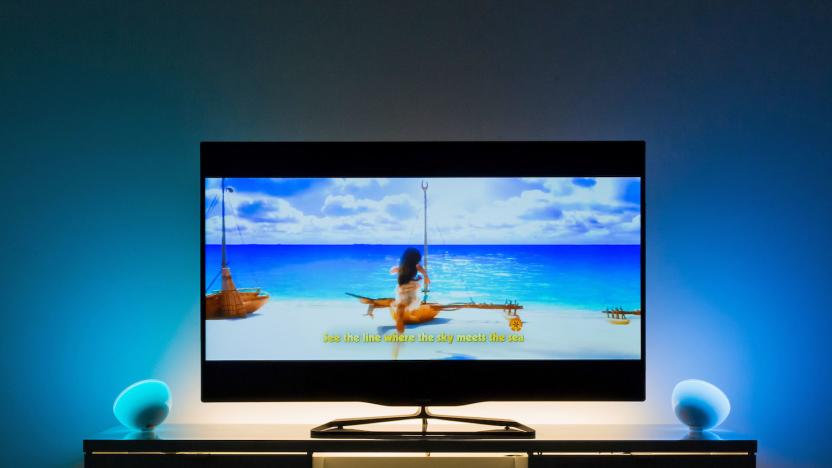
Philips' Hue lights will soon sync with movies, games and music
In the five years since Philips introduced its Hue range, it's been joined by many other companies offering their own version of its smart lighting. To stay ahead of the competition, the electronics giant has focused on adding platform partners, while introducing new bulbs that appeal to every kind of homeowner. To celebrate its fifth birthday, Philips confirmed today that it will further extend the compatibility of its kit and allow owners to synchronize their lights with movies, video games and music.

Zigbee crafts a universal language for smart home devices
As seamless as smart-home technology is becoming, the devices still tend to sit in isolated ecosystems. Zigbee-based gadgets don't normally know how to use Nest's Thread protocol, for example. That's where the Zigbee Alliance wants to help. It's launching Dotdot, a "universal language" for Internet of Things devices. The open platform lets hardware makers use Zigbee's software layer across virtually any other IoT network, increasing the chances that the devices you want to use can speak to each other.
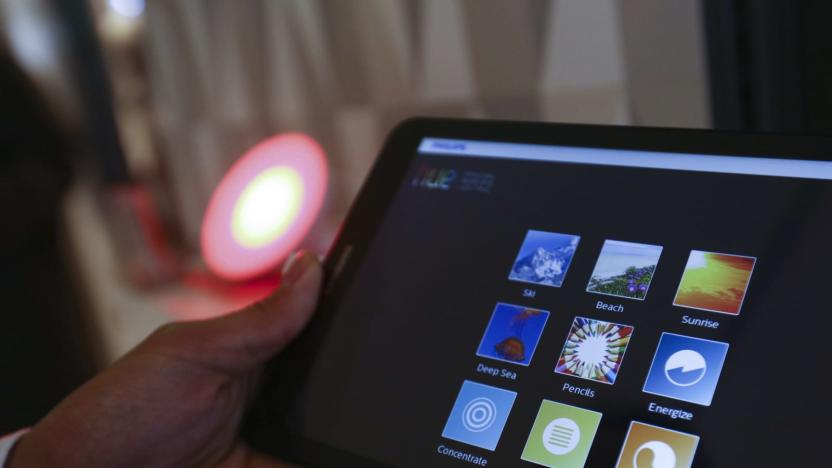
Hackers hijack Philips Hue lights with a drone
Surprise! The Internet of Things is a security nightmare. Anyone who was online a few weeks ago can attest to that. The massive internet blackout was caused by connected devices, and new research from white-hat hackers expounds upon those types of vulnerabilities. The target? Philips Hue smart lightbulbs. While they've been hacked in the past, Philips was quick to point out that it happening in a real-world situation would be pretty difficult. Digital intruders would need to already be on your home network with a computer of their own -- the company claimed that directly attacking the lightbulbs wasn't exactly feasible. But this new attack doesn't require that sort of access.

LG home automation hub gives you pro-level security
It's no longer difficult to find both home automation and security in a single package, but LG thinks it can one-up its rivals with something special... if a bit odd-looking. Its previously previewed Smart Security device may look like an upscale colander, but it serves as both a smart home hub (for Bluetooth, WiFi, Z-Wave and Zigbee) and a wide-angle security camera backed by ADT. It's already equipped to notify you when there's unusual movement or changes in temperature, but a $20 ADT Canopy subscription will get you all-day monitoring with a dedicated response team. In theory, you won't have to bend over backwards to get help if there's a break-in.

Researchers find major security flaw with ZigBee smart home devices
Manufacturers of smart home devices using the ZigBee standard are aiming for convenience at the expense of security, according to researchers from the Austrian security firm Cognosec. By making it easier to have smart home devices talk to each other, many companies also open up a major vulnerability with ZigBeee that could allow hackers to control your smart devices. And that could be a problem if you rely on things like smart locks or a connected alarm system for home security. Specifically, Cognosec found that ZigBee's reliance on an insecure key link with smart devices opens the door for hackers to spoof those devices and potentially gain control of your connected home.

Cree's affordable smart bulb works with Zigbee and Wink home hubs
Sure, being able to control your lights using an app is cool and all, but smart bulbs are typically (frustratingly!) expensive. If you don't mind getting basic features on a basic bulb, though, Cree has a new $15 option now out at Home Depot -- that's the same price as GE's Link Bulbs and a lot cheaper than, say, Philips Hue models. You can't change its colors and use it as disco lights, but you can dim, brighten or schedule it to switch on at a specific time through the accompanying iOS and Android app. Also, the company claims it's shatter-proof despite the price point and can last for up to 25,000 hours. It still needs to be connected to a Wink or a ZigBee hub to work, which means more $$$ if you don't have either yet. But if you already own one of those hubs, Cree's connected bulb doesn't sound like such a shabby choice.

Belkin's WeMo home sensors track everything and the kitchen sink
Do you want to know every little nuance of what's going on in your home? You'll want to give Belkin's new WeMo home sensors a look, then. The surprisingly wide range of household trackers includes a door-and-window sensor, a keychain tracker, a motion detector and a water efficiency monitor -- there's even an alarm sensor that listens for sounds from other sensors, like smoke detectors. All of the devices will alert you if something's amiss, whether you're worried about intruders or tend to run the kitchen faucet for too long. And like the rest of Belkin's highly modular WeMo hardware, they'll frequently work in tandem with other gadgets on the platform. They can turn on the lights when you step into a room, or ramp up the air conditioning only when your window is closed. Most of the sensors will arrive in the second half of 2015, with pricing coming later. The water sensor is still in field testing, however, so it won't be ready to analyze your plumbing until the tail end of the year.

Stack's smart light bulb responds to the world around you
Many smart light bulbs... well, aren't. You can control them, but they're often blissfully unaware of what's going on in your home. Stack aims to change that with its recently unveiled Alba bulb. This sensor-packed illuminator changes brightness and color based on the time of day, location and who's present in the room. It'll start with cooler, more natural white hues when you're just waking up, but will switch to relaxing warm colors when it's late. It will also dim or shut off the lights when there's a lot of ambient light, or if you've left for work; alternately, it will come to life when there's a big commotion. There's a mobile app if you need to tweak settings, but the goal is to avoid using it as much as possible. Much like a Nest thermostat, Alba will learn appropriate behavior and (hopefully) let you keep your phone in your pocket.

Logitech extends Harmony line to control more of your home
Logitech's got a new Harmony remote and it's an even bigger push into home automation over the current Harmony Smart Control home theater remote lineup. Shipping this month, the new Harmony Home Control devices start at $99 for the Home Hub (which turns your smartphone or tablet into a home automation controller). Then there's the Home Control for $149, which adds a simple, button-only remote. At the top of the line is the $349 Harmony Ultimate Home, which swaps out the simple remote for a 2.4 inch touch screen model (seen above). Available in either black or white, Harmony Home can control both your home theater and other devices from partners via IR, Bluetooth or WiFi. There's a lengthy list of support, too: August, Honeywell, Kwikset, Lutron, Nest, PEQ, Philips, Schlage, SmartThings, Sylvania, Yale and Zuli.

TiVo's new Mini is close, but it could be missing the WiFi we're waiting for
The TiVo Mini is a great little device and add-on if you've got one of the company's DVRs, but there's one small problem: no built-in wireless connection. That means you'll need a coax cable, Ethernet cord or wireless bridge to get video from your DVR or pull up internet apps like Netflix and Hulu Plus. It's not always convenient and devotees like our friend Dave Zatz have been waiting for a model with wireless since the original debuted last year. The good news (other than the fact that Mini owners can ditch the $6 per month subscription fee for a $50 "Lifetime" activation) is that a new model is coming, and its FCC listing means there's some wireless kit in it. The bad news? It doesn't seem to mention WiFi, only a 2.4GHz "Zigbee" connection. The new TGN-TCDA93000 (Mini) is even listed on TiVo's own website, and while there's not much mentioned about what it does, we have a few guesses.

PĒQ marks Best Buy's entrance into smart home market
All the big players are getting into the smart home/connected device market. First, Google acquired Nest, then came word last week that SmartThings was bought by Samsung. While Apple is staying away from connected device hardware, iOS 8 will bring a home automation framework to iPhone and iPad through HomeKit. Today, big box retailer Best Buy announced that it is bringing Icontrol Networks' smart home platform directly to consumers through a home automation service called PĒQ. Icontrol Networks' products have primarily been available in the past through security and telecom providers such as ADT Pulse and TWC Intelligent Home, although the company's Piper security cam/automation hub has been directly available to consumers since earlier this year. You'll be able to get a variety of home automation products at Best Buy through the PĒQ brand, everything from a connected thermostat à la Nest to light switches, cameras, water sensors, window and door sensors, and more. Devices that use the Zigbee RF protocol should work with the PĒQ home automation hub. A PĒQ representative noted that they're using a single protocol to avoid latency and interference problems that happen with "universal" hubs supporting multiple protocols. Like many of the other home automation/security providers, PĒQ will offer a service for storing security video, setting up rules and text alerts, and update equipment firmware. The service is reasonably priced at US$9.99 per month, with no subscription required. While you can take a look at the PĒQ ecosystem and purchase products right now at the website, you'll have to wait until August 31 to buy the products on the BestBuy.com website or at selected store locations.

GE promises smart light bulbs without the usual steep prices
Many smartphone-controlled light bulbs cost a pretty penny, even if you're not interested in mood-setting colors or other elaborate tricks. How are you supposed to afford enough bulbs to illuminate your entire abode? That's where GE's new Link bulbs could save the day. While you'll need a hub ($30 by itself) to get everything connected, the LED-based white lights cost just $15 to $25 each -- in contrast, Philips' upcoming Lux models are $40 a pop. There's also a kit that includes two 60W-equivalent bulbs and a hub for $50, or half as much as you'd pay for an equivalent Lux bundle.

Revolv Smart Home Hub and app eases home automation setup
As noted in my Macworld/iWorld 2014 talk on using Siri to control the "Internet of Things", there's one big problem in the home automation world right now -- too many standards! Now I know that sounds like a contradiction in terms, but there are a number of competing standards available: Z-Wave, Zigbee, Insteon, Sonos, Belkin WeMo and more. Several manufacturers are attempting to corral this stampeding herd of standards with smart hubs. We've already reviewed one here at TUAW (the US$99 SmartThings Hub) and now it's time to take a look at the $299 Revolv Smart Home Hub and the companion app that controls it. Over the past few years I've been building up my home automation world by purchasing bits and pieces as I've had a chance. As a result, I have a number of Belkin WeMo switches, wall switches, and motion sensors, some SmartThings sensors (moisture, motion), and some other Z-Wave devices that I've picked up along the way. In this review, I'll tell you about how the Revolv hub is set up, how it recognizes and controls the various devices, and how the free Revolv iPhone app works to tie all of your home automation devices together. Setup The Revolv Smart Home Hub is incredibly simple to install. You just plug in the included AC adapter and plug the other end into the red teardrop-shaped hub. There's no need to run an Ethernet cable to the Revolv hub, which is quite different from competing hubs. Instead, you launch the Revolv app and tap a button to begin the new hub setup. That basically requires you to identify the network that your iPhone and the Revolv hub will be on, and then enter the password for that network. Once that's done, you're asked to put the camera flash from your iPhone right over the top center of the hub, and the fireworks begin. What kind of fireworks? Well, all sorts of rapid-fire flashing takes place as your iPhone communicates to the hub via light. Wait a short while and then the hub is up and running. At that point, you can have it begin to search for connected devices on your network. This is where things got a little interesting. At this time, I have a number of devices on my home automation network, including some door/window switches, moisture sensors, and a number of Belkin WeMo devices. Well, the Revolv hub found a few (but not all) of the WeMo switches and a WeMo motion sensor, but couldn't find the other devices that communicate on the Z-Wave protocol. Revolv has a list of compatible devices online, and even has links to those products on Amazon. But if you have devices that just aren't compatible, your only choice is to let the company know through a "suggestion box" and then hope that others vote for that device to be added. In comparison with the SmartThings hub, the Revolv hub doesn't appear to me to have as much range or as much compatibility with a wide variety of sensors and switches. I initially started out with the Revolv hub in nearly the same spot as the SmartThings hub was during its testing, and it couldn't detect many of the devices that the SmartThings hub picked up immediately. Even moving the Revolv hub to other locations didn't seem to help. Actions Rather than use IFTTT to allow mashups in an almost-infinite variety, Revolv's app has the ability to create actions. One of my first tests was to do something that took me no time to accomplish with WeMo's own rules and that's to have a specific light in the house turned on when someone trips the sensor, then turn off the light after a certain amount of time has elapsed. When I tried using Revolv's actions to do this, I could get the light to turn on, but then it turned off immediately. As far as I could tell, there was no way to get that to turn off after a set period of time. What I finally ended up doing was something that's supposed to be resolved with a hub: using an app specific to the problem at hand, in this case the WeMo app. That's not to say that Revolv's actions and app aren't useful -- they just weren't in this particular case. Some of the other actions include having lights go on as you get near your home, as the hub determines its location during setup and the app uses iOS 7's Location Services to figure out where you are at any particular time. Along with location-driven actions, the Revolv app also provides actions based on the status of a device (on or off) and on time. Design Although the Revolv hub costs about three times the amount of the SmartThings hub, it looks cheaper. The red, plasticky exterior of the Revolv hub might be attractive to some home automation fans, but to me the sleek white exterior of the SmartThings hub is preferable and blends into a lot more homes. On the other hand, not having to plug in an Ethernet cable makes it possible to place the Revolv hub in a lot more locations. Conclusion The Revolv Smart Home Hub wins kudos from me for its simple setup process. However, the lack of breadth of sensors that can be controlled (moisture sensors, for example), the inability to create mashups with IFTTT, and the relatively high price are three sticking points for me. IFTTT integration vastly expands the abilities of the competing SmartThings hub, making it possible to do such bizarre things as receive a phone call from your house when a plumbing leak is detected or activate an alarm when severe weather is approaching. I won't count Revolv out of the picture yet -- the company says they still have three more radio standards to implement in the device, and it appears to be moving forward on adding support for new devices all the time. Rating: 2-1/2 stars out of 4 stars possible

SmartThings Hub: Connecting your home, phone and you
At Macworld/iWorld 2014, I delivered a talk about Siri and connected devices titled "Siri's Arms and Legs: Giving Apple's Intelligent Assistant the Power to Control Your World." My original idea for the presentation was based on some work I'd done last year for YouTube's Geek Week, in which I used a combination of Siri, IFTTT, and Belkin WeMo switches to make some videos that I called "Stupid WeMo Tricks". But as I got into my research for the presentation it occurred to me that the world of app-centered home automation has gone well beyond just the WeMo products and into the realm of making most items in your home either controllable or able to be monitored. One company that kept coming up on my radar during my research was SmartThings, a Washington, DC-based company that is building a solid foundation for an app-controlled smart home with the US$99 SmartThings Hub. The Hub works with a free iPhone app and a growing number of connected switches and sensors that operate with either the Z-Wave or ZigBee home automation protocols. Many people that I talked to before and after my Macworld presentation said almost the same thing, variations on a theme of "I'd love to control my home but it's too hard to do, too expensive, and I don't want to have to search through a pile of apps to do one thing or another." Well, that's the reason SmartThings and some other companies are coming up with intelligent hubs. The idea is that a single hub can control a number of devices through one app. Setting up the SmartThings Hub and a variety of the switches and sensors is a piece of cake. The hub simply needs to be plugged into a power source and then have an Ethernet cable run over to your Internet router. Once you've done a first-time setup with the SmartThings app, adding devices to your home automation network is easy. Some of the devices, such as a motion sensor, door and windows switches, and a moisture sensor, are battery powered. These devices usually just required that a plastic tab be pulled out to allow the device to start up -- in some cases, however, I had to open the device up and press a reset button to get the app to recognize it. Still, setup took no time at all. Other devices such as light and appliance modules plug into a wall socket and start up immediately. It should be noted that many of the plugged-in Z-Wave modules, like the Jasco Fluorescent Light and Appliance Module (at left, below, seen with a motion detector), work to extend your home automation network by creating a mesh network. SmartThings does a good job of adding new devices to their online shop, and also provides a good blog that gets into details on how to do certain things. As an example, I really thought it would be great to automate my garage door opener so that I could tell via the SmartThings app if it was open or closed, then control it remotely. But my garage door opener is at least 20 years old, so I figured I was out of luck. Sure enough, the SmartThings blog had an article on using a Z-Wave Relay Switch in parallel with an existing "dumb" garage door opener to add it to the Internet of Things. My credit card was out of my wallet to buy the Z-Wave Relay Switch... and now I have a fun weekend project to do. One of my other favorite "pieces" of SmartThings gear is the SmartSense Presence key fob (below). When registered with your app, this little proximity sensor knows when you've left the house -- and if everyone in the house has one, it knows when the house is empty. That means that you can set one of the SmartThings SmartApps to react appropriately to that "state". The SmartApps might best be described as presets that do something for you without needing an intermediary like IFTTT. As an example, let's say that I want to be alerted if my washing machine starts flooding the laundry room. I have a moisture sensor set on the floor right next to the washer (image below) that will tell me when things are getting a bit wet. I can be informed of an impending flood one of two ways -- either I can connect my SmartThings hub and the moisture sensor to IFTTT using the SmartThings channel, and then create a quick recipe to have IFTTT call my phone and say "I have detected water underneath the washing machine", or use the pre-defined Flood Alert! SmartApp to send me a text. Since I'm a geeky guy and like getting robotic phone calls warning me of impending catastrophes, I chose to use IFTTT -- but for many people the SmartApp would make the job even easier. SmartThings has created tons of SmartApps that can be discovered by device (outlet, moisture sensor, door sensor), by convenience (turn off all of the lights in the house when everybody is gone), by family (monitor motion sensors in an elderly person's home and then contact someone if they don't return from the bathroom after a specified amount of time), by "fun" (send a text when motion is detected), by "green living" (send a text notification to a carpooling buddy when they are not with you and you arrive to pick them up), by safety and security (lock a door automatically when I leave), and more. The great thing about the SmartThings world is that they've created an easy-to-use ecosystem that is growing everyday, and they've built plenty of flexibility into both the hub and the app. The company's online store sells both devices and full-fledged solutions, the latter being helpful for people who want a particular solution but have no clue as to how to implement it. At this point in time, the world of connected devices and home automation is still a bit on the pricy side, which is why I have to commend SmartThings for at least making the Hub affordable. As more and more connected devices become available, prices should eventually drop. Right now, you can expect to spend prices similar to these -- $49 for a door/window multi-sensor, $54 for a moisture sensor, $55 for a motion sensor, $31 for one of those key fob proximity sensors, $49 for a ZigBee-based lamp switch, $58 for that relay switch I'm going to use for my garage door opener, $60 for a multi-sensor that can monitor motion, temperature, brightness and humidity, and so on. Things like connected deadbolt locks cost in the range of $200 each. So what do you get out of connecting all of these devices to your house and your body (the key fob or your phone)? The ability to do some pretty magical things. I love how the SmartThings app lets me see all of my connected devices on one screen, although you'll want to take a picture of each device's location to be able to tell them apart. Having one app to control many things in my house must be how Frodo Baggins felt having the "one ring to rule them all"! I've already posted a few articles on TUAW about the Internet of Things and these connected devices, and I'll be writing about some of the solutions I've implemented as I build my home automation network. I have to say that in all of my testing, I have been impressed with the stability of the SmartThings Hub -- it hasn't failed me despite having been challenged by power and Internet outages. It's comforting to know that the home automation network quickly comes back online by itself in those cases. In the near future I'll also be providing a review of a similar hub from Revolv, as well as a Z-Wave compatible sensor and security camera from BlackSumac called Piper. Conclusion SmartThings has brought an affordable intelligent home automation hub to market with a smart iOS app to control it, then provided even more flexibility by providing an IFTTT channel for creating custom solutions. If you're thinking about dabbling with home automation, SmartThings has a complete ecosystem built around solutions or individual devices. Rating: 4 stars out of 4 stars possible

Samsung's Smart Bulb edges closer to launch as it gains US approval
Philips may be at the forefront of connected lighting with its Hue range, but could soon have a competitor in Samsung's "Smart Bulb," which has just popped up at the FCC. The Korean outfit first revealed plans for a wireless bulb earlier in the year, and expected to launch a three-piece kit during the third quarter, complete with ZigBee hub for issuing on/off and dimming commands from mobile devices. That kit never came, but the FCC approval of this Smart Bulb, which uses ZigBee and looks mighty similar to what Sammy's detailed before (see below the fold), suggests it's nearly ready to illuminate your gloomy pad. Hue might have a budding adversary on its hands, but one thing's for sure -- we're not likely to see Samsung's effort taking a prime slot in Apple's storefront anytime soon.










